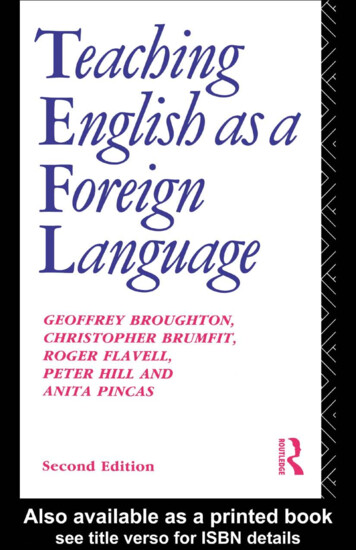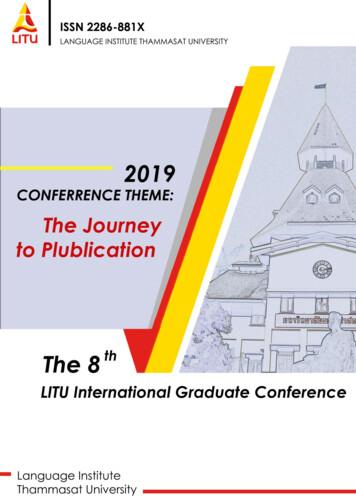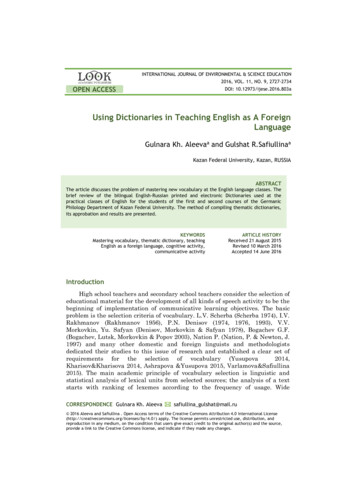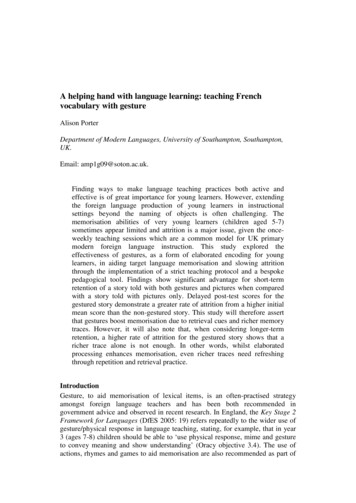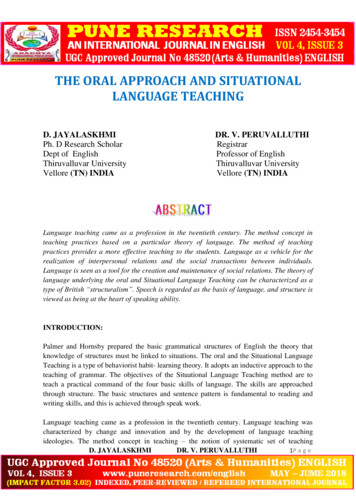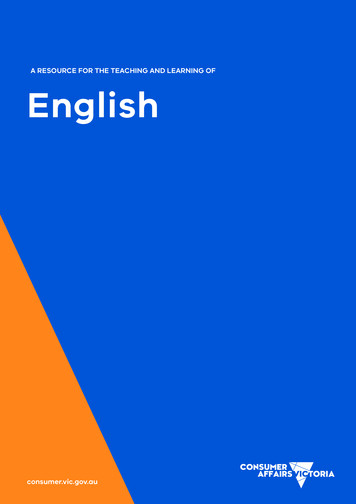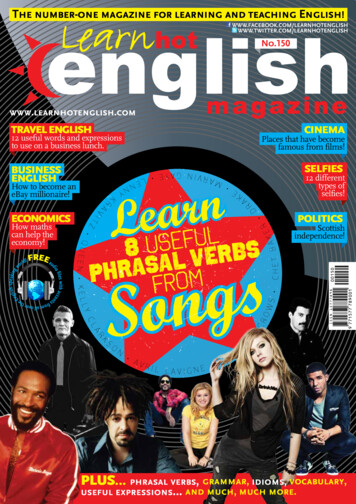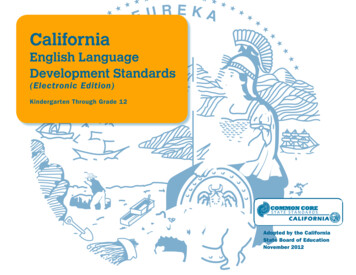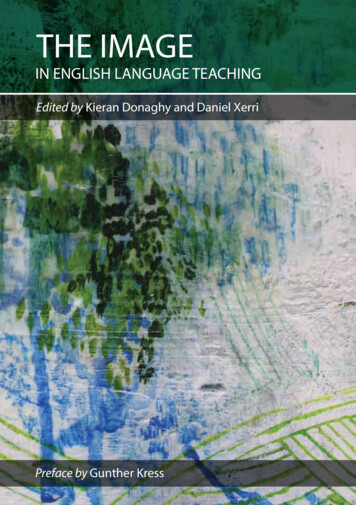
Transcription
THE IMAGEIN ENGLISH LANGUAGE TEACHINGEdited by Kieran Donaghy and Daniel XerriPreface by Gunther Kress
THE IMAGEIN ENGLISH LANGUAGE TEACHING
THE IMAGEIN ENGLISH LANGUAGE TEACHINGEdited by Kieran Donaghy and Daniel Xerri
Published by ELT CouncilMinistry for Education and EmploymentGreat Siege RoadFloriana VLT 2000MaltaCopyright for whole volume ELT Council 2017Copyright for individual papers remains vestedin the contributors, to whom applications forrights to reproduce material should be made.First published 2017ISBN 978-99957-1-151-1Cover artwork by Emma Louise PrattDesigned by Perfecta Marketing Communications.Printed in Malta by Gutenberg Press.
Throughout the history of education, communication has been at the centreof the experience, regardless of subject matter. We can’t learn (or teach) whatwe can’t communicate and, increasingly, that communication is being donethrough visual media.Stephen ApkonWe must teach communication comprehensively in all its forms. We live andwork in a visually sophisticated world, so we must be sophisticated in using allthe forms of communication, not just the written word.George LucasThis book is dedicated to all critical and creativeimage users and makers in ELT.
ContentsPreface – Making meaning: from teaching language to designingenvironments for learning in the contemporary worldGunther Kress1. The image in ELT: an introductionKieran Donaghy & Daniel Xerri2. Image makers: the new language learnersof the 21st centuryAnna Whitcherix1133. A history of video in ELTBen Goldstein234. The power of videoAntonia Clare335. The power of image nation: how to teacha visual generationMagdalena Wasilewska436. Using Pinterest to promote genuinecommunication and enhance personalised learningAndreia Zakime517. Teaching visual literacy through memes inthe language classroomElena Domínguez Romero & Jelena Bobkina598. Colors in images: developing color vocabularyand meanings in the EFL classroomCandy Fresacher719. Learner-sourced visuals for deeper text engagementand conceptual comprehensionTyson Seburn7910. Images on canvas: art, thinking and creativity in ELTChrysa Papalazarou11. Looking back at ekphrastic writing: museum educationtasks in the language classroomSylvia Karastathi12. Peace art: words and images interwovenMagdalena Brzezinska13. The teaching artist in language learning: how tocreate an Artists in Schools ProjectEmma Louise Pratt89105117129vii
14. The picture and the storyPaul Dummett14515. Learning by design: language learningthrough digital games155Paul Driver16. Using graphic novels and comics with ELT learnersSamantha Lewis16517. Cartoons and comics: communicating with visualsJean Theuma17918. Pictures that tell the truth: deconstructing theteaching/learning spaceValéria Benévolo FrançaAbout the contributorsviiiThe Image in English Language Teaching189197
PrefaceMaking meaning: from teaching language to designingenvironments for learning in the contemporary worldGunther KressUniversity College London, United KingdomThe social world, and with it the world of meaning is, by a now pretty wellsettled view, fundamentally different to that world as imagined (or actual)some three or four decades ago. All the papers in this volume reflect thatsense: an unease that our frames, our theories and tools, are no longeradequate to the shapes and the requirements of the contemporary worldof meaning. The semiotic world has changed, yet our theories remain – byand large, uneasily – those we had and which seemed usefully adequate“then”. The semiotic world is a mirror, even if not perfect, of a social worldin which former boundaries have blurred, weakened or disappearedentirely, with consequent effects on “language”. One major aspect ofthis are the phenomena captured under the label of globalization: withits all-embracing effects in relation to language, language learning andlanguage teaching.The effects of these social and semiotic changes are apparenteverywhere, though nowhere more insistently so than in subjects todo with representation and communication, and hence with AppliedLinguistics, in all its various manifestations (the Teaching of Englishbeing one), very much in the foreground. Here the “blurring” or“disappearance” of boundaries finds its clearest expression in relationto the means for making and communicating meaning. Where before‘one’ could and did talk and write relatively dismissively about “theextra-linguistic” or “the para-linguistic”, these phenomena have movedinto the centre of representational and communicational attention.Language – whether as speech or as writing – is now most usually onepart only of compositions comprising a number of entirely differentmeans for making meaning. Speech occurs jointly with ensembles ofgesture, posture, gaze, movement. Writing occurs in compositions withimage, colour, in the specific arrangements of layout. Frequently neitherspeech nor writing are central: they are partial expressions of the overallix
meaning of such composition. In very many instances attention tospeech or writing provides a partial account only of the overall meaningof the communicational ensemble.If speech or writing are now means for the partial expression ofmeaning, several unavoidable questions arise for the teacher of alanguage for those who are not familiar with that language, nor withits social environments of use. The first question may be “if writing ispartial here – in this ensemble of resources for making meaning, forcommunication – then in what ways is it partial?” The second questionmight be: “In what social environments do speech or writing tend tohave what kind of role?” And if the question is posed – as in this volume– in relation to English Language Teaching, the third utterly essentialquestion is “in what ways are the uses, the forms and degrees of partiality,similar to or different from the social uses of the learner’s first (or other)language(s) in differing social environments?”The absolutely taken-for-granted presence of a multiplicity ofresources for making meaning – of “modes” in multimodal approaches –makes all teaching into the task of designing semiotically apt environmentsfor learning: “apt” in terms of the requirements and understandings oflearners, and apt in relation to that which is being communicated. Puttingit differently: the designs for learning have to be apt for both curriculum –the matter taught – and pedagogy – the social relations in environmentsof teaching and learning. In the case of the teacher of a “foreign language”,her or his task now is hugely more difficult and hugely more rewarding incontemporary environments.The papers in this volume admirably illustrate the range of issuesthat arise. The task for both practitioners/teachers and for theorists is toproduce frames, apt theories, and apt tools for an understanding of theseissues in the present unstable and hugely complex world.xThe Image in English Language Teaching
1. The image in ELT: an introductionKieran DonaghyUAB Idiomes Universitat Autònoma de Barcelona, SpainDaniel XerriELT Council, MaltaThe vast majority of language teachers use images in their classroom. Intoday’s increasingly visual world, it is difficult to imagine the languageclassroom without coursebook images, photographs, paintings,cartoons, picture books, comics, flashcards, wallcharts, YouTube videos,films, student-created artwork and media, and so on. However, despitethe ubiquity of images in language teaching, we need to ask whetherimages are being approached merely as an aid or support, or as asignificant component of communicating in a foreign language, and as ameans of fostering students’ communicative competence and creativity.In order to answer this question, we need to examine how images havebeen approached in resource books and coursebooks.IMAGE RESOURCE BOOKSIn his 1966 seminal study The Visual Element in Language Teaching, PitCorder made the distinction between “talking about images” (merelydescribing images) and “talking with images” (responding personallyto images). The influence of this work on the use of images in languageeducation has been immense. Since this seminal book, there have been anumber of practical resource books, such as Alan Maley et al.’s The Mind’sEye (1980), Andrew Wright’s Pictures for Language Learners (1990), DavidA. Hill’s Visual Impact (1990), Ben Goldstein’s Working with Images (2009),Jamie Keddie’s Images (2009), and Peter Grundy et al.’s English Through Art(2009). These books promote the critical and creative use of still imagesin the language classroom, and encourage students to interpret imagesand analyse their reaction to them.Perhaps the most influential video methodology book for teachersis Cooper et al.’s Video (1991). This ground-breaking book was the first toestablish the principle of active watching: that rather than just watchinga video passively and answering listening comprehension questions,1
students should play a much more active viewing role. Students wereinvolved in information gap tasks and engaged with the video on a muchmore meaningful level. Subsequently, a number of guides such as SusanStempleski and Barry Tomalin’s Film (2001), and Jane Sherman’s UsingAuthentic Video in the Language Classroom (2003) contained practicalsuggestions for activities built upon the principle of active viewing. Morerecently, Ben Goldstein and Paul Driver’s Language Learning with DigitalVideo (2014), Jamie Keddie’s Bringing Online Video into the Classroom(2014), and Kieran Donaghy’s Film in Action (2015) have focused not juston activities to exploit existing video content available on video-sharingsites such as YouTube and Vimeo, but also on making and using learnergenerated videos and short films.However, despite the fact that there are many resource books thatpromote the critical and creative usage of both still and moving images,resource books sell very few copies and it can take a long time before theactivities proposed in them are adopted by authors of the much betterselling coursebooks. For better or worse, ELT coursebooks have a hugeinfluence on teachers’ methodology. As Peter Viney (2017) recounts,I angered a group of teachers in Japan by stating thatHeadway had had a far greater influence on what happensin the ELT classroom than the entire collected works ofStephen Krashen. In practical terms, coursebooks are thefilter through which theory reaches the classroom. It’s athick filter with an inbuilt delay system, but the good ideastrickle through eventually.To better understand the role of images in the language classroom, it isnecessary to examine how they are used in coursebooks.IMAGES IN COURSEBOOKSWhen considering the use of still images in coursebooks, one is struckby the fact that the power of images to stimulate ideas, discussionand creativity is still currently underexploited in the majority of them.According to well-known coursebook writer Ben Goldstein (2009),With the advent of large-scale ELT publishing, images wereused not only as visual reinforcement, but in order to makethe finished product more attractive and hence moremarketable. However, although texts are largely taken2The Image in English Language Teaching
from ‘authentic’ sources to reflect the real-life languagethat the books promote, the images are still largely madeup of archive photos. Such images not only lack originality,but more often than not project and promote an affluentand aspirational lifestyle to learners. For this reasonELT materials, however, contemporary they are in topicand outlook, often appear to have a superficial, coloursupplement ‘look’ to them. Teachers and learners tend notto be presented with images that they would encounter inthe real world, but rather a safe cleaned-up version. (p. 4)In addition to this sanitised use of images in coursebooks, there is thecriticism that images are still largely used as aids and for decoration.In a recent study of the usage of images in three intermediate ELTcoursebooks for young adults and adults, David A. Hill (2013) found thatover half of photos and drawings were used only for decoration:It seems to be that having over 50 per cent of the picturesin a given coursebook used for purely decorative purposesis a great waste of effort on the part of the publisher anda great waste of opportunity for the language learner andteacher. (p. 163)Of course, upon examining an ELT coursebook, one is also struck by thedominance of monomodal texts over the type of multimodal texts thatstudents are engaging with on a daily basis outside the classroom.However, despite the fact that the majority of coursebooks still useimages largely for support and decoration, and monomodal texts aregenerally dominant, recently there has been a clear trend towards usingimages to stimulate ideas and discussion. In an increasing number ofcoursebooks, such as Life (National Geographic Learning), Eyes Open/Uncover (Cambridge University Press), Keynote (National GeographicLearning), and The Big Picture (Richmond), at the start of each unit largehigh-impact non-stock images are being used as a springboard to helpestablish the topic, activate schemata and get students talking.Having looked at how images are used in ELT coursebooks, it is nownecessary to explore how videos are used as more and more coursebooksare integrating video. When we look at how video is used, we discoverthat it is still largely regarded as glorified listening. Video is used as a wayof doing listening comprehension tasks but with the support of moving1. The image in ELT: an introductionKieran Donaghy & Daniel Xerri3
images to help with non-verbal communication. It is still largely exploitedfor comprehension-based tasks such as multiple-choice questionsand language-based tasks such as gap-fills. However, an increasingnumber of coursebooks are exploiting video not just for language orcomprehension-based activities, but also for more communicative andcreative tasks in wh
through digital games 155 Paul Driver 16. Using graphic novels and comics with ELT learners 165 Samantha Lewis 17. Cartoons and comics: communicating with visuals 179 Jean Theuma 18. Pictures that tell the truth: deconstructing the teaching/learning space 189 Valéria Benévolo França About the contributors 197 viii The Image in English .

